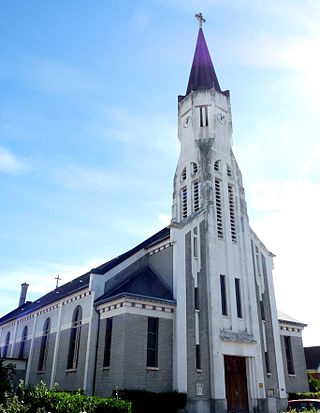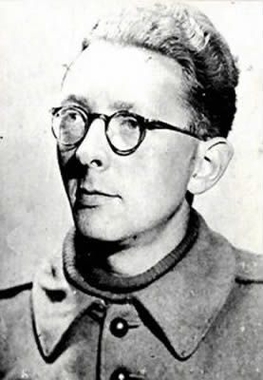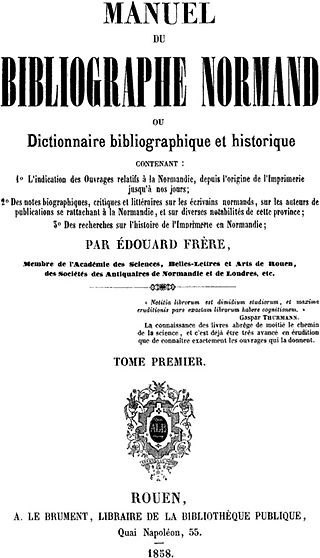
Le Havre is a major port city in the Seine-Maritime department in the Normandy region of northern France. It is situated on the right bank of the estuary of the river Seine on the Channel southwest of the Pays de Caux, very close to the Prime Meridian. Le Havre is the most populous commune of Upper Normandy, although the total population of the greater Le Havre conurbation is smaller than that of Rouen. After Reims, it is also the second largest subprefecture in France. The name Le Havre means "the harbour" or "the port". Its inhabitants are known as Havrais or Havraises.

Seine-Maritime is a department of France in the Normandy region of northern France. It is situated on the northern coast of France, at the mouth of the Seine, and includes the cities of Rouen and Le Havre. Until 1955 it was named Seine-Inférieure. It had a population of 1,255,633 in 2019.

Maurice Marie Émile Leblanc was a French novelist and writer of short stories, known primarily as the creator of the fictional gentleman thief and detective Arsène Lupin, often described as a French counterpart to Arthur Conan Doyle's creation Sherlock Holmes.
The Compagnie des chemins de fer de l'Ouest, often referred to simply as L'Ouest or Ouest, was an early French railway company which operated from the years 1855 through 1909.

Sotteville-lès-Rouen is a commune and railway town in the Seine-Maritime department in the Normandy region in northern France.

René Binet was a French militant political activist. Initially a Trotskyist in the 1930s, he espoused fascism during World War II and joined the SS Charlemagne Division. Soon after the end of the war, Binet became involved in numerous neo-fascist and white supremacist publications and parties. He wrote the 1950 book Théorie du racisme, deemed influential on the European far-right at large. Binet died in a car accident in 1957, aged 44.

Édouard Frère was a French bookseller, archivist, biographer, and historian specialized in the Normandy area.

Pierre-Nicolas Beauvallet, was a French sculptor, draftsman and printmaker.

Robert Antoine Pinchon was a French Post-Impressionist landscape painter of the Rouen School who was born and spent most of his life in France. He was consistent throughout his career in his dedication to painting landscapes en plein air. From the age of nineteen he worked in a Fauve style but never deviated into Cubism, and, unlike others, never found that Post-Impressionism did not fulfill his artistic needs. Claude Monet referred to him as "a surprising touch in the service of a surprising eye".

Eustache-Hyacinthe Langlois was a celebrated French painter, draftsman, engraver and writer. He became known as the "Norman Callot". He taught both his daughter Espérance Langlois and his son Polyclès Langlois and they often assisted him with drawings and engravings.

Le Travailleur du Centre Ouest was a communist weekly newspaper published from Limoges, France. Le Travailleur du Centre Ouest was the regional organ of the French Communist Party in Limousin. It was founded as a continuation of the Communist Party newspaper in Corrèze, Le Travailleur de Corrèze, and the communist organs in Creuse and the Haute-Vienne.

La Voix de l'Est was a French Communist Party local weekly newspaper published from Bagnolet, France. The newspaper was founded in 1932. In 1935, it had a circulation of 8,000 and by 1937 the circulation had reached 12,1000. In the mid-1930s Coudert, the mayor of Bagnolet, was the director of the newspaper.

L'Enchaîné du Nord et du Pas-de-Calais was a Communist Party weekly newspaper published from Lille, France, published on Fridays. Stêphane Dubled was the editor-in-chief of l'Enchaîné.
Le Travailleur de Lot-et-Garonne is a communist weekly newspaper published from Agen, France. The first issue of Le Travailleur de Lot-et-Garonne was published on October 4, 1919. The newspaper, then an organ of the local socialists of Agen under the leadership of Renaud Jean, survived its initial period by enlisting 500 subscribers.

Albert Lebourg, birth name Albert-Marie Lebourg, also called Albert-Charles Lebourg and Charles Albert Lebourg, was a French Impressionist and Post-Impressionist landscape painter of the Rouen School. Member of the Société des Artistes Français, he actively worked in a luminous Impressionist style, creating more than 2,000 landscapes during his lifetime. The artist was represented by Galerie Mancini in Paris in 1896, in 1899 and 1910 by : Galerie Bernheim-Jeune, 1903 and 1906 at the Galerie Paul Rosenberg, and 1918 and 1923 at Galerie Georges Petit.
The following is a timeline of the history of the city of Le Havre, France.
Jean-Louis-Théodore Bachelet was a 19th-century French historian and musicologist.
Louis-Henri Baratte was a French scholar from Criquetot-l'Esneval, Normandy.













